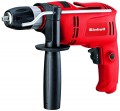Power consumption
The total power consumed by a mains-powered electric tool (see "Power Source"). It is considered the main criterion for assessing the overall capabilities of a particular model: more power allows you to achieve more speed and/or torque. However a more correct parameter for such an assessment is useful (working) power, but it is far from always indicated, and tools of the same type with similar power consumption usually do not differ much in terms of working power. In addition, data on power consumption also allows you to estimate the load on the power grid or other power source; in some cases this is unnecessary.
As for specific figures, for different types of tools, the characteristic power values will be different. For example,
from 750 to 1000 W is considered a very solid indicator for a screwdriver, while for classic drills this is an average value, among such devices there are options even for
1.5 kW or more. Detailed recommendations on choosing a tool for this parameter can be found in special sources. We only note that it does not always make sense to chase the maximum values high power noticeably affects the dimensions, weight and price of the unit, despite the fact that it is far from always required.
Rotation speed
The speed of rotation of the working nozzle provided by the tool.
If a single number is indicated in this paragraph (for example, 1800), it can be either a standard, constant, or maximum rotation speed. This refers to the maximum speed if the tool has more than one speed (see "Number of speeds") and/or a speed controller (see "Functions"). In turn, two or three numbers through an oblique line (for example, 1100/2300/3400) are indicated only for models that have the corresponding number of individual speeds. Each of these numbers indicates the standard (and in the presence of a speed controller — the maximum) number of revolutions at one of the speeds.
Anyway, when choosing a tool by the number of revolutions, it is worth considering both its general type (see "Device") and the specifics of the intended work. Detailed recommendations on this matter are quite extensive, it makes no sense to give them in full here — it is better to turn to special sources. We note only a few general points. So,
high -speed drills nowadays are considered to be drills capable of delivering more than 3000 rpm. In general, high speed contributes to productivity, but there is also a downside: increasing the speed (for the same power) reduces torque — accordingly, the efficiency of working with stubborn materials and large diameter nozzles decreases. Therefore, it makes sense to specifically look for a "high-speed" tool only if speed is of key impor
...tance; it doesn’t hurt to make sure that the model you choose can provide the required efficiency and torque.Max. beats
The number of beats per minute provided by a tool that supports the corresponding mode.
For more information about this mode, see "Functions", here we note that it can be provided both in drills and in screwdrivers and wrenches (see "Device"), and the meaning of the impact mode in these varieties is somewhat different. Therefore, the speeds differ: many drills are capable of delivering about 48,000 beats / min, or even 64,000 beats / min, while in screwdrivers and wrenches, 3200 beats / min are considered “classics of the genre”, and values above 3500 beats / min are practically do not meet.
The general meaning of this indicator is also directly related to the type. So, among drills, the difference in chiseling speed can be quite large. With these tools, more strokes improve overall productivity and efficiency, while fewer strokes improve accuracy and reduce the risk of damaging delicate materials. In screwdrivers and nutrunners, high speed also contributes to overall efficiency, but for most of these tools, the differences in this indicator are not significant enough to be noticeable in practice.

